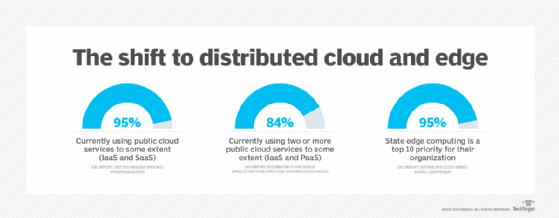AnsibleFest 2022: Automation across distributed environments
IT environments are more distributed than ever, making infrastructure management increasingly challenging. Ansible's automation capabilities can help IT ops handle the complexity.
Earlier this month, I was in Chicago to attend the AnsibleFest 2022 conference. Like many events taking place this year, it was the first in-person AnsibleFest in about three years. In-person attendance increases overall energy and crowd participation and enables speakers to have a relationship with attendees.
Since the last in-person event, a lot has changed. IT environments have continued to become even more distributed, with applications spread across private data centers, multiple public clouds and edge locations. Employees are distributed across homes, offices and the road. As a result, underlying IT infrastructures -- and especially networks -- have become more complex to deploy and manage.
This is where Red Hat Ansible can play a significant role. To operate more efficiently, organizations must be able to automate tasks, including initial system setup and configuration, as well as Day 2 tasks. The demand for automation capabilities was evident at AnsibleFest 2022, as the event was completely sold out. Many in the crowd were first-time attendees eager to learn how to optimize the Ansible platform in their technology domain or, more often, extend those capabilities across other domains in their enterprise.
The event had two keynotes, one each day. These were delivered entirely by members of Ansible chief Tom Anderson's team rather than by Anderson himself, as is usually the case. I think it is great when a leader lets his team shine and strengthen its relationship with the community. Great job to Kaete Piccirilli for kicking things off and emceeing the event. Kudos to Matthew Jones, Stefanie Chiras, Walter Bentley, Adam Miller, David Duncan, Chad Ferman, David Rapini and Ruchir Puri for keeping the keynotes entertaining, informative and on time.
The following are key takeaways from the keynotes.
Shifting to an automation mindset. Organizations must embrace automation. This is required both at the executive level and from operations teams. It is often said that creating the technology is the easy part; changes to culture and process are difficult. Ansible has created the Ansible Automation Platform technology to bring automation to heterogeneous environments that span multiple technology domains, such as server, OS, networking and security. The technology continues to expand its coverage, moving forward into areas including public and hybrid cloud, IoT, edge, DevOps and as-a-service environments.
IT changes are occurring at a faster pace as digital transformation initiatives continue to accelerate, so it's important for organizations to embrace automation. Tribal knowledge and individual acts of IT heroism will only last so long with the great resignation and experts aging out of the workforce. Organizations need to codify that knowledge into platforms to retain it and provide work-life balance for operations teams to retain top talent.
Supporting distributed cloud environments. Ansible will be in the AWS Marketplace and provide support for Microsoft Azure, rounding out support for the top three cloud vendors and increasing support for edge environments. Enterprise Strategy Group (ESG) views this as positive, as our research continues to validate the shift to distributing applications across private data centers, multiple public clouds and edge locations.

In fact, when it comes to the edge, around 49% of respondents to an ESG survey stated that the ability to centrally manage all edge environments, and even automate areas of the deployment, was one of the most important factors in the decision-making process for edge computing.
Event-Driven Ansible (EDA). I thought this update from the event was really cool. EDA enables the Ansible Automation Platform to kick off an automation runbook based on an externally generated event. This enables organizations to take advantage of the intelligence, such as AI and machine learning (ML), added to vendor-specific devices to generate alerts and potentially even recommendations. This then triggers the Ansible Automation Platform to automate remediation. Organizations can standardize on an automation platform across their entire IT estate while taking advantage of vendor- and device-specific knowledge. This works well for organizations becoming comfortable with AI, ML and automating the remediation process.
For example, ESG research in networking highlights that 20% of organizations just want to get an alert and then go find and fix the problem manually. The majority (59%) want an alert and recommendation on what to fix, but then want to solve it manually. The remaining 21% want to fully automate the solution.
With Ansible, organizations can manually trigger automation in the second phase -- alert and recommend -- and then switch to event-driven automation when they are comfortable that the alert, recommendation and automated remediation processes are validated and accurate. When building out the automation component, organizations should include a closed loop to ensure that changes deliver the desired results.
Project wisdom. This project, which uses technology developed by IBM, focuses on how AI and ML can help organizations build out runbooks faster. The goal is to reduce the amount of time needed to create automation runbooks. This could greatly accelerate the adoption of the Ansible Automation Platform in new technology domains and reduce the amount of training required to become competent for a specific domain or vendor.
Right now, the Ansible team is looking for the community to jump in, try it out and provide feedback. I expect that as this technology matures, we'll learn from community feedback and eventually see more validated content.
Now that AnsibleFest 2022 is in our rearview mirror, planning for next year's event has probably already started. You can bet that, based on the demand for the event this year, it will be held in a bigger venue.
As organizations continue to embrace distributed cloud environments as part of their digital transformation efforts, it is important to recognize that these modern environments are also more complex. This places more pressure on operations teams to ensure consistent deployments, configurations and policies while maintaining availability, security and positive user experiences.
To do this without burning out operations teams, organizations must leverage AI and automation to drive higher levels of operational efficiency. The Ansible Automation Platform is on the right track to enable organizations to achieve this goal with its heterogenous vendor support across technology domains spanning data centers, public clouds and edge locations.
ESG is a division of TechTarget.






